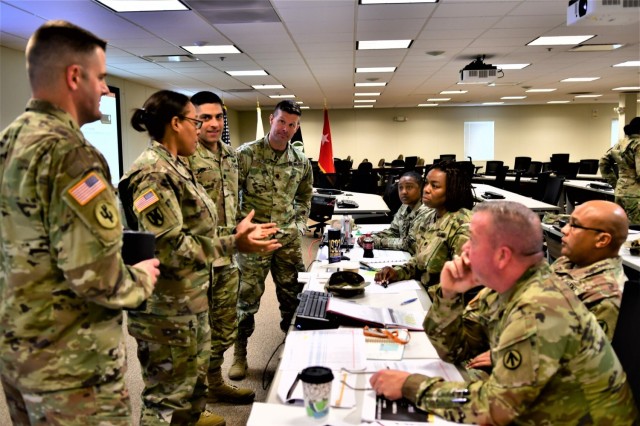

SCOTT AIR FORCE BASE, Ill. – The Military Surface Deployment and Distribution Command's G-37 Mission Support Section conducted a Training and Mission Support Summit here November 15-17 to improve integration of the command’s active and Reserve component forces.
Planners from SDDC’s headquarters staff, its active component transportation brigades, and its Reserve force, the Deployment Support Command, gathered to identify active component brigade mission-support requirements for fiscal years 2023 and 2024 and collaborated to source initial training events that allow SDDC’s Reserve component units to support mission-essential tasks while achieving desired proficiency levels in their own prioritized tasks.
The purpose of the summit was to match and validate sourced training opportunities with the Deployment Support Command capabilities, resulting in increased readiness for mission requirements in fiscal years 2023 and 2024.
“It takes a total integrated force solution across all components to have the capabilities that we need to support the joint force,” said SDDC commanding general Maj. Gen. Gavin A. Lawrence.
This year's summit, the first to be conducted in-person since the Coronavirus pandemic, marked the beginning of SDDC's current command planning and preparation for the integration of its total force.
“We are aware of the effects the Coronavirus has played on the nation and the military, creating challenges to how the military would conduct training and execute missions, while developing mitigation strategies to overcome these changes,” said Col. Demetria Walker, SDDC’s G-37 chief.
“Planning and prioritization of capabilities remain the focal point for the summit, because its where we focus on challenges, improvements, and a way ahead in forming an agreement with the DSC to build and maintain readiness,” added Walker.
The summit used Army Field Manual 7-0 (Training Management Cycle) as the lens to shape training opportunities and to array SDDC forces in preparation for future Large Scale Mobilization Operations/Large Scale Combat Operations.
“The TMSS incorporated the training management cycle found in FM 7-0 to enable SDDC headquarters and subordinate units to prioritize training, planning and preparation, execution, and the evaluation and assessment of training,” said Lt. Col. Randall Sumbles, G-37 Mission Support chief.
The DSC is vital to the success of SDDC’s wartime mission, and the TMSS helped to synchronize the SDDC commander’s priorities with the DSC commander’s training priorities.
“As we contribute to the conversations about requirements for mission support, we are being flexible to give the DSC opportunities for the areas where they lack support to contribute to the team efforts with our total force integrators,” said Armando Castro, 595th Transportation Brigade deputy operations officer.
The summit concluded with a briefing on past, present, and future training expectations, establishing realistic and challenging training opportunities, including challenging conditions and different environments, to ensure that task proficiencies are met and directly contribute to the end-state of increasing readiness across all DSC capabilities.
The agreements established between SDDC's active component and Reserve component planners will ensure that resulting training plans satisfy the requirements for mission support teams and adequately resource units to attain required training proficiency levels.
“We must ensure proper planning and synchronization of the command’s active and Reserve organizations to ensure global mission readiness of the command in support of training, mobilization, and contingency operations,” said Lawrence.


Social Sharing